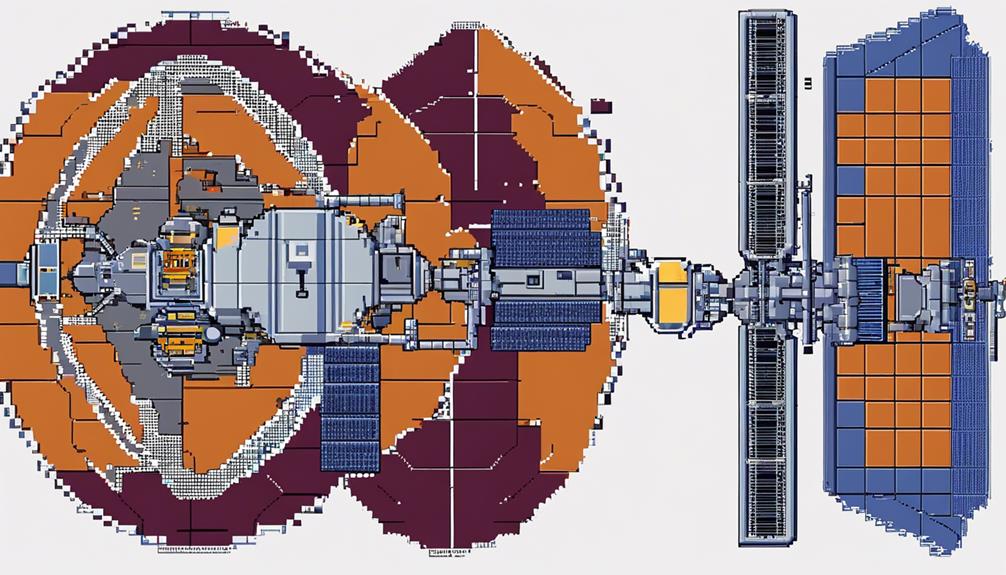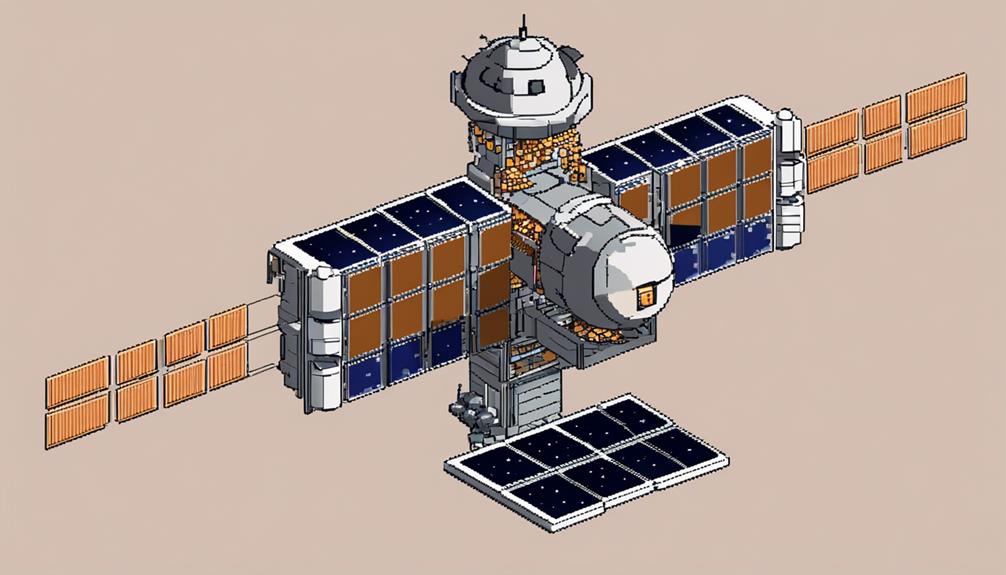The intricate interplay between thermal control systems and the operational longevity of satellites is a cornerstone of space technology. As spacecraft venture into the harsh environment of space, the delicate balance of temperature regulation becomes a mission-critical aspect. From passive thermal control systems silently orchestrating heat dissipation to active systems dynamically managing thermal loads in real-time, the precision required is unparalleled. Delving into the intricacies of heat pipes, radiators, and innovative thermal management techniques unveils a world where every degree matters in safeguarding the functionality and integrity of satellites amidst the chilling vacuum and scorching radiation of space.
Key Takeaways
- Multi-layer insulation and active systems ensure optimal temperature regulation in satellites.
- Integration of advanced thermal technologies like heat pipes and louvers enhances performance.
- Active thermal control systems play a crucial role in managing heat for efficient satellite operation.
- Future focus on innovative solutions and efficiency testing for improved longevity and performance.
Passive Thermal Control Systems

Passive thermal control systems in satellites are designed to regulate component temperatures without the need for powered equipment, utilizing various components such as Multi-Layer Insulation (MLI) blankets, coatings, heat pipes, and sunshades. These systems are particularly advantageous for SmallSats and CubeSats due to their cost-effectiveness, low weight, and simplicity. Structural and electrical design methods play a critical role in ensuring the effectiveness of passive thermal control systems in small spacecraft.
In the context of SmallSats and CubeSats, where mass, volume, and power constraints are significant factors, passive thermal control systems offer a practical solution for temperature regulation. MLI blankets, coatings, thermal straps, louvers, and interface materials are examples of passive thermal control components utilized to maintain optimal temperature levels in small satellites. By efficiently managing heat dissipation and absorption through these components, passive thermal control systems contribute to the overall success and longevity of the satellite missions.
The strategic placement of MLI blankets, coatings, and sunshades, coupled with the integration of heat pipes for thermal conductivity, forms a comprehensive passive thermal control approach. This approach not only aids in stabilizing internal temperatures but also protects sensitive components from extreme thermal fluctuations in the space environment. The careful selection and application of these passive thermal control elements are essential to the reliable operation and performance of SmallSats and CubeSats in orbit.
Active Thermal Control Systems
In contrast to passive thermal control systems that rely on non-powered components, Active Thermal Control Systems (ATCS) in satellites utilize powered elements such as heaters, louvers, and refrigerators to actively regulate spacecraft temperatures with precision. These systems play a crucial role in maintaining optimal operating temperatures for critical spacecraft systems and components. By actively adjusting heat exchange mechanisms, ATCS ensure that the satellite functions within the designated temperature range.
| Key Elements of ATCS | Description |
|---|---|
| Heaters | Resistive electric heaters are used to add heat to the spacecraft when needed. |
| Louvers | Louvers control the amount of thermal radiation entering or leaving the satellite. |
| Refrigerators | Refrigerators are utilized to remove excess heat from the spacecraft. |
| Mechanical Pumps | Mechanical pumps circulate coolants or fluids to manage temperature distribution. |
The powered components within ATCS work together to regulate the heat flow within the satellite, ensuring that sensitive equipment operates at optimal conditions. The resistive electric heaters can increase the temperature in specific areas, while the mechanical pumps facilitate the circulation of coolants to dissipate excess heat. Additionally, the use of louvers and refrigerators enables precise control over the thermal environment of the satellite. Overall, ATCS are essential for the overall health and functionality of satellites by actively managing thermal conditions.
Importance of Thermal Regulation

Efficient heat management techniques and precise temperature control strategies are fundamental aspects of thermal regulation in satellites. These methods are essential to safeguard the integrity and functionality of critical spacecraft components under varying thermal conditions. By implementing effective thermal regulation measures, satellites can maintain optimal operating temperatures, ensuring the longevity and reliability of onboard systems.
Heat Management Techniques
Precision in maintaining specific temperature ranges for critical components of satellites is paramount for ensuring optimal performance and longevity in space missions. Thermal management techniques play a crucial role in controlling heat within spacecraft systems. Active thermal control systems are utilized to regulate temperatures, preventing overheating or freezing that could jeopardize the functionality of electronics, batteries, and propulsion systems. Insulation methods such as multi-layer insulation (MLI) blankets and coatings help in managing heat absorption, dissipation, and storage effectively. Louvers are also employed to balance energy exchanges in the harsh space environment. By implementing these heat management techniques, spacecraft can operate reliably in extreme temperature conditions, enhancing overall performance and durability of satellite systems.
Temperature Control Strategies
Continuing our exploration of thermal management in satellites, the focus now shifts towards discussing the critical aspect of Temperature Control Strategies and the paramount importance of Thermal Regulation in maintaining optimal performance and longevity of spacecraft systems in the demanding space environment.
Key Points:
- Temperature Stability: Ensuring specific temperature ranges in spacecraft components for reliable operation.
- Prevent Damage: Protection against extreme temperatures to prevent harm to electronics, propulsion systems, and exterior surfaces.
- Optimal Performance: Safeguarding efficiency by maintaining temperature limitations crucial for the functionality of various spacecraft components.
Functionality of Heat Pipes
Utilizing a phase change process with a working fluid, heat pipes play a crucial role in efficiently transferring heat over significant distances within spacecraft. These passive devices are integral components of the thermal control subsystem, contributing to the effective management of heat dissipation and temperature regulation in space environments. Heat pipes leverage the high thermal conductivity of the working fluid and the principles of evaporation and condensation to facilitate heat transfer without the need for mechanical components.
In spacecraft thermal control systems, heat pipes are commonly used in various configurations, including loop heat pipes, to address different thermal management needs. The operation of a heat pipe involves the evaporation of the working fluid in the evaporator section due to heat input, creating a vapor that moves towards the cooler condenser section. In the condenser, the vapor condenses back into a liquid, releasing the latent heat, which is then transferred away from the spacecraft's critical components. This cyclic process enables heat to be efficiently transported across long distances within the spacecraft, ensuring uniform temperature distribution and preventing overheating of sensitive equipment. Overall, heat pipes serve as reliable and efficient tools for passive heat transfer in the demanding environment of space missions.
Role of Radiators in Satellites

The efficient management of thermal loads in satellites relies significantly on the strategic integration of radiators designed for optimal heat rejection. Radiators in satellites are crucial components of the thermal control system design, playing a pivotal role in maintaining the spacecraft's operating temperatures within acceptable limits. Here are key points regarding the role of radiators in satellites:
- Heat Rejection: Radiators are essential for dissipating excess heat generated by onboard components into space. By efficiently rejecting heat, radiators prevent the spacecraft from overheating and ensure the proper functioning of critical systems.
- Thermal Conductivity: Radiators are typically constructed using materials with high thermal conductivity to enhance heat transfer capabilities. This property allows for effective dissipation of heat from the spacecraft, helping to regulate internal temperatures.
- Optimized Design: The size and design of radiators are carefully calculated to meet the specific thermal control requirements of the satellite. Engineers must consider factors such as the amount of heat to be rejected, the spacecraft's operating environment, and the overall thermal management strategy to design radiators that can effectively manage thermal loads.
Radiators play a crucial role in enhancing the longevity and performance of satellite systems by effectively dissipating heat and maintaining optimal operating conditions for onboard components. The strategic integration of radiators in satellite thermal control systems is vital for ensuring mission success and overall spacecraft functionality.
Future Trends in Satellite Thermal Management
Advancing satellite thermal management involves integrating Active Thermal Control Systems (ATCS) to enhance temperature regulation efficiency. Future trends in satellite thermal management are focused on adopting advanced technologies such as Loop Heat Pipes (LHP) and Capillary Pumped Loops (CPL) to improve heat transportation within satellites. These technologies offer greater efficiency in managing thermal loads and maintaining optimal operating temperatures. Additionally, Variable Conductance Heat Pipes (VCHP) and Pumped Two-Phase Loops (PTPL) are emerging as innovative solutions for the design of thermal control systems in satellites. By incorporating these systems, satellite operators can achieve more precise control over thermal conditions in varying environmental scenarios.
Efficiency testing is a critical aspect of implementing these advanced thermal management systems to ensure their reliability and performance under different operating conditions. Moreover, the optimized use of louvres and shutters is gaining importance in satellite design to regulate heat exchange with the surroundings effectively. Considering the time spent in orbit and the satellite's surface orientation is also crucial for developing efficient heat provision methods. By addressing these factors, the future of satellite thermal management aims to enhance overall system efficiency and reliability, ultimately improving the performance and longevity of satellites in space.
Frequently Asked Questions
What Is the Active Thermal Control System for Satellites?
Active thermal control systems for satellites utilize a combination of passive cooling methods, heat exchangers, and active regulation mechanisms to manage temperature fluctuations. These systems are designed to efficiently control temperatures through radiative cooling, thermal insulation, and cryogenic systems. Components such as solar panels, thermal blankets, and thermal cycling techniques are integrated to ensure precise temperature management and thermal stability in satellite operations.
Why Is Thermal Control Necessary in Satellite Communication?
Thermal control is essential in satellite communication to regulate heat, ensuring temperature stability for optimal signal strength and communication reliability. Effective thermal management enhances system efficiency, preventing overheating or freezing of critical components. It also aids in orbit adjustment to counteract thermal expansion, provides radiation protection for data transmission, maintains thermal balance for solar panels, and prolongs longevity through insulation materials. Proper thermal design supports space exploration by optimizing antenna performance and facilitating heat dissipation for satellite operations.
What Is an Example of a Thermal Control System?
An example of a thermal control system is Multi-Layer Insulation (MLI), comprising layers of insulating materials like fiberglass and Teflon to regulate heat transfer. MLI blankets are crucial for passive heat management in various industries. Other thermal control systems include passive radiators, cryogenic coolers, heat pipes, thermoelectric coolers, thermal blankets, phase change materials, thermal coatings, radiative cooling, and thermal modeling. These systems play vital roles in maintaining desired temperatures in diverse applications.
What Is the Thermal Control Subsystem of a Spacecraft?
The thermal control subsystem of a spacecraft is a critical component responsible for ensuring proper thermal regulation within the vehicle. This system is designed to manage heat dissipation, temperature management, and protection of key components from extreme conditions in space. Utilizing passive systems, radiative surfaces, and cryogenic cooling technology, the thermal control subsystem plays a crucial role in maintaining thermal stability, optimizing energy efficiency, and preserving the integrity of the spacecraft during thermal cycling.

